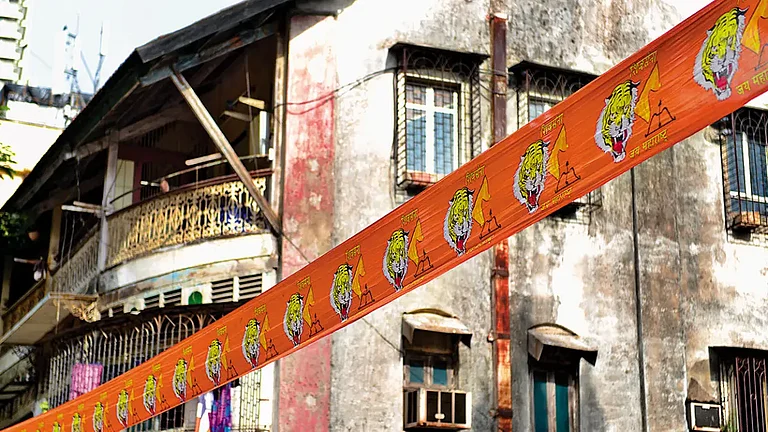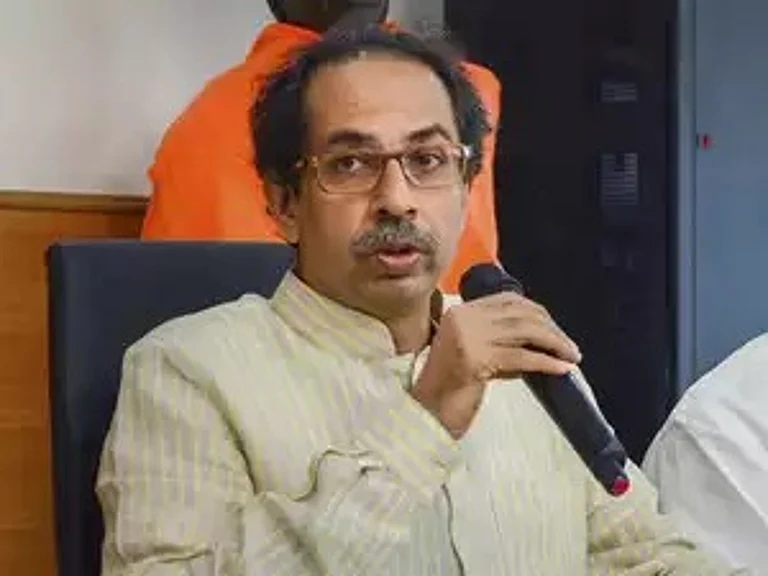On the evening of June 29, as heavy rains lashed Mumbai, a calm and smiling Uddhav Thackeray, leader of the ruling coalition of Maha Vikas Aghadi, appeared Live on Facebook. Nine days ago, Eknath Shinde, 58, a top leader of the Shiv Sena and Minister of urban affairs in the ruling Maha Vikas Aghadi (MVA) government, and a group of 40 Sena MLAs declared they were leaving Shiv Sena and joining the opposition, Bhartiya Janata Party. The two parties, rebels proclaimed, had enough numbers to take power from Uddhav and install a new government in Mantralaya.
Will The Real Shiv Sena Please Stand Up?
Uddhav’s Sena is not just different from Bal Thackeray’s Sena in terms of personality and leadership, but also in the core principles of political ideology and language.

Thackeray’s response to the unruly upheaval was cool-headed. “I don’t want to play the number game,” Thackeray said in the Facebook speech while urging his party workers to not come in the way of Shinde and the 40 rebels. “Democracy must be upheld. We will do it and so must all. Let them enjoy the deed of pulling down Sena supremo’s son from the post of CM,” Uddhav said rendering his resignation.
His calm demeanour while braving the political storm, his invoking of democracy, and his appeal to the Shiv Sainiks to follow the law and stay away from physical violence, were antithetical to the leadership of his father and the party’s founder Bal Thackeray.
“If even a single MLA from Shiv Sena defects then kick him in the middle of the road, without worrying about the law….these b****as should get such punishment only. There is no need for a warning, this is the question of our survival,” Bal Thackeray thundered in an expletive-laden speech in Marathi at a crowded public rally in 1994-95, exhorting Shiv Sainiks to act with vengeance against those leaving the party.
Uddhav’s Sena is not just different from Bal Thackeray’s Sena in terms of personality and leadership, but also in the core principles of political ideology and language.
On June 19, 1966, Bal Thackeray laid the foundation of a political party called Shiv Sena and placed a roaring tiger as its emblem. The South Indian migrants became the party’s first targets and Shiv Sainiks attacked Udupi restaurants in Dadar. The party contested civic elections scored big wins in Thane and Bombay and progressed from being the opposition party in the state to the winning party. In 1995, Sena-BJP ended Congress dominance and came to power in the state with Manohar Joshi as the chief minister. The party also came to power in the BMC after losing the civic body to Congress. It has maintained its hold on the country’s richest municipal corporation from 1997 until now. The party officially renamed Bombay to Mumbai after the city’s reigning deity Mumba Devi.
The party grabbed headlines for violence and ruckus which became its trademark during demonstrations. Shiv Sainiks dug out cricket pitches in Mumbai and Delhi to protest India’s cricket match with Pakistan. It launched protests against Fire movie for depicting the lesbian relationship between two women named after Hindu goddesses, Valentine’s Day, author Salman Rushdie, artiste M F Hussain, and journalists seen writing against its politics.
The big question in Maharashtra as the state heads for yet another round of Lok Sabha and legislative assembly elections in 2024 is whether or not Uddhav’s faction will survive politically. And will Shinde’s Sena maintain its winning record? What is Shiv Sena without the Thackeray family's name?
Uddhav’s Sena has fielded 17 candidates from its party across Maharashtra. The faction is determined to win big and retain its hold on Mumbai. Thane, Kalyan, and Bhiwandi constituencies fall under Shinde Sena’s influence and will see a tough fight from the rival Uddhav faction. Party workers want to see the downfall of the rebel Shinde, starting from his son MP Shrikant Shinde's defeat in Kalyan constituency
The Election Commission has recognised Shinde’s faction as the ‘real’ Shiv Sena based on the majority factor. Shiv Sena’s name and party symbol of bow and arrow are now with the Shinde faction, whereas Uddhav has named his faction Uddhav Balasaheb Thackeray with an emblem of burning mashal.
Since 2022, the party has seen more defections with veteran Sena leaders shifting to the winning party alliance of Shinde Sena and the BJP. In several cases, the switch came after the Enforcement Directorate laid raids upon the leaders. Shinde’s rebellion has been a hard blow and a massive setback to the Uddhav faction, but it was not shocking, leaders said.
“This was an expected development. We have in fact told all the leaders, those who wish to leave, should do it now,” Harshal Pradhan, spokesperson for the Uddhav faction, said. He recalled that the party had braved through several high-profile rebellions in the past but it did not alter Shiv Sena as the party’s unique hierarchical structure of Sena shakhas manned by its local activists, corporators and senior leaders on the ground remained intact.
In 1991, Chhagan Bhujbal rebelled against the Shiv Sena leadership and joined the Congress (then united Congress) with 18 rebels. Narayan Rane also defected in 1995 to join the Congress and later BJP. And Uddhav’s cousin, Raj Thackeray, left Shiv Sena in 2005 and announced his intention to start a new political party, called the Maharashtra Navnirman Sena. Pradhan said of all the past rebellions, Sainiks were hurt the most by Raj’s exit, as he was part of the Thackeray clan.
According to Sanjay Patil, a research scholar on politics and elections at Mumbai University, Raj Thackeray was considered as the heir apparent of Balasaheb as he closely resembled his stylish appearance, dashing personality and aggressive speaking style. “When he left the party there was a panic, but look at his party’s performance. He was never able to convert mass support into votes.”
Raj Thackeray has once again been brought in the fray. The BJP has roped him to corner Marathi votes. Media reports suggest, that the BJP is trying to sweeten the deal by coaxing him to merge the MNS with Shinde Sena and take the leadership of the party – a ghar wapsi for Raj Thackeray in the true sense.
Patil observed that Shiv Sena’s fate has been written over numerous times in the past, but the party is not dead. “Shiv Sena is different from all other political parties in Maharashtra because it has evolved to be a people's party. It has an emotional connection with the Thackerays and it is not easy to tear that apart.” For Mumbaikars, Shiv Sena is Thackeray and Thackeray’s are Shiv Sena, the seat of power --the party’s headquarters Sena Bhavan in Dadar, and Thackeray family residence at Matoshree in Kalanagar in Bandra, are political landmarks and even venues to seek 'quick' justice.
Uddhav faces tremendous challenges ahead as he tries to retain the party’s existence and identity in the forthcoming elections, he added. “People see that he is a good administrator, his handling of the Covid-19 crisis made a difference. Despite all the challenges thrown against him, he has stood tall and held the party together. Thackeray’s Sena is not dead.”
Shiv Sena might have fragmented and its politics evolved over the years, but the affinity of Marathi people remains with the Thackeray family. The party still remains the only voice of the Marathi people, in Mumbai and elsewhere in Maharashtra, with its slogan of Jai Maharashtra (Victory to Maharashtra).
- Previous Story
 ‘Staying Out Of Power Has Made Congress Desperate’: PM Modi Slams Rahul Over ‘Country On Fire’ Remark
‘Staying Out Of Power Has Made Congress Desperate’: PM Modi Slams Rahul Over ‘Country On Fire’ Remark - Next Story


























